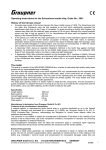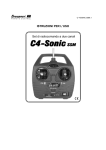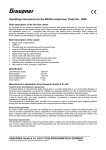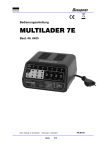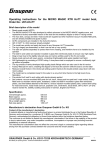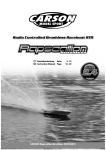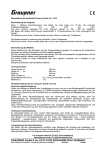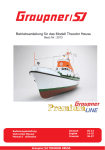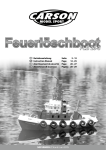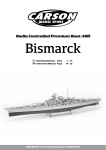Download 1 Operating Instructions for the BISMARCK model ship
Transcript
Operating Instructions for the BISMARCK model ship, Order No.: 2089 / 2089.G History of the full-size vessel • • • • • Accurate scale model of the famous former German War Navy’s battleship of 1939. The Treaty of Versailles placed a limit of 10,000 tonnes on new warships built by Germany, and this restricted such vessels to the Deutschland class of armoured ships such as the Graf Spee. It was not until the signing of the Anglo-German Naval Agreement of June 1935 that Germany officially gained the right to build battleships with a standard displacement of up to 35,000 t. However, these limitations were ignored, with the result that the Bismarck’s eventual displacement in fighting trim was around 42,000 t. When commissioned in August 1940 the vessel was the world’s largest and most powerful battleship. The Bismarck gained notoriety by playing a part in Operation ‘Reinübung’ in conjunction with the Prinz Eugen. During this mission HMS Hood was sunk by a salvo from the Bismarck. During the battle the Bismarck was also damaged, so Admiral Lütjens decided to steam back to Brest for repairs. However, the ship was attacked during this voyage by Swordfish torpedo bombers, suffering rudder damage as a result, and this made it impossible to escape from the British ships chasing her. On 27 May she was finally hunted down by two battleships and two heavy cruisers in the North Atlantic, and went to the bottom about 550 nautical miles from Brest. Order No. 2089: model of the Bismarck at the time of Operation ‘Reinübung’ whilst lying at Bergen. Order No. 2089.G: model of the Bismarck at the time of her sinking (with decals) and at the time of commissioning (without decals). The model This boat is a member of the GRAUPNER PREMIUM line, a series of particularly high-quality readymade models with an unprecedented level of detailing. The core of this high-quality model is the robust moulded GRP hull, complemented by the superstructure and deck which are constructed from laser-cut ABS parts. Many of the small items are of metal, and almost everything is factory-assembled. The hull, parts of the superstructure, the masts and fittings are spray-finished using semi-matt paints, and the decals are already applied. The many details and scale fittings give the boat an impressive scale appearance. The ample deck openings make it a simple matter to install the RC components, and the procedure is quickly completed. To prepare the boat for running all you have to do is install the RC components and the drive battery, carry out a little soldering, and the model is ready for the water. Specification Overall length approx. Beam approx. Overall height approx. All-up weight Scale approx. 1670 mm 240 mm 414 mm 14 kg 1 : 150 Manufacturer’s declaration from Graupner GmbH & Co KG Contents of the manufacturer’s declaration: If material defects or manufacturing faults should arise in a product distributed by us in the Federal Republic of Germany and purchased by a consumer (§ 13 BGB), we, Graupner GmbH & Co. KG, D73230 Kirchheim/Teck, Germany, acknowledge the obligation to correct those defects within the limitations described below. The consumer is not entitled to exploit this manufacturer’s declaration if the failure in the usability of the product is due to natural wear, use under competition conditions, incompetent or improper use (including incorrect installation) or external influences. This manufacturer’s declaration does not affect the consumer’s legal or contractual rights regarding defects arising from the purchase contract between the consumer and the vendor (dealer). Extent of the guarantee If a claim is made under guarantee, we undertake at our discretion to repair or replace the defective goods. We will not consider supplementary claims, especially for reimbursement of costs relating to the defect (e.g. installation / removal costs) and compensation for consequent damages unless they GRAUPNER GmbH & Co. KG D-73230 KIRCHHEIM/TECK No liability for printing errors. We reserve the right to introduce modifications. 1 GERMANY #00596367 12/2009 are allowed by statute. This does not affect claims based on legal regulations, especially according to product liability law. Guarantee requirements The purchaser is required to make the guarantee claim in writing, and must enclose original proof of purchase (e.g. invoice, receipt, delivery note) and this guarantee card. He must send the defective goods to us at his own cost, using the following address: Gliders Brunel Drive, Newark, Nottinghamshire, NG242EG The purchaser should state the material defect or manufacturing fault, or the symptoms of the fault, in as accurate a manner as possible, so that we can check if our guarantee obligation is applicable. The goods are transported from the consumer to us and from us to the consumer at the risk of the consumer. Duration of validity This declaration only applies to claims made to us during the claim period as stated in this declaration. The claim period is 24 months from the date of purchase of the product by the consumer from a dealer in the Federal Republic of Germany (date of purchase). If a defect arises after the end of the claim period, or if the evidence or documents required according to this declaration in order to make the claim valid are not presented until after this period, then the consumer forfeits any rights or claims from this declaration. Limitation by lapse of time If we do not acknowledge the validity of a claim based on this declaration within the claim period, all claims based on this declaration are barred by the statute of limitations after six months from the time of implementation; however, this cannot occur before the end of the claim period. Applicable law This declaration, and the claims, rights and obligations arising from it, are based exclusively on the pertinent German Law, without the norms of international private law, and excluding UN retail law. Important safety notes You have acquired a kit which can be assembled into a fully working RC model when fitted out with suitable accessories. However, we as manufacturers have no control over the way you build and operate your RC model boat, nor how you install, operate and maintain the associated components, and for this reason we are obliged to deny all liability for loss, damage or costs which are incurred due to the incompetent or incorrect use and operation of our products, or which are connected with such operation in any way. Unless otherwise prescribed by binding law, the obligation of the GRAUPNER company to pay compensation, regardless of the legal argument employed, is excluded. This includes personal injury, death, damage to buildings, damage due to loss of business or turnover, interruption of business or other direct or indirect consequent damage whose root cause was the operation of the model. The total liability in all cases is limited to the amount of money which you actually paid for this model. This model boat is built and operated at the sole and express responsibility of the operator. The only way to avoid injury to persons and damage to property is to handle and operate the model with the greatest care and consideration at all times. Before you run the model for the first time please check that your private third-party insurance covers the operation of model boats of this kind. If in doubt, take out a special insurance policy designed to cover modelling risks. These safety notes should be kept in a safe place. If you ever dispose of the model, be sure to pass them on to the new owner. The following points are important and must be observed at all times: • This model is not suitable for young persons under fourteen years of age. • The projecting parts of the model may be sharp, and the aerials and masts could cause eye injuries. • Bear in mind that tools can be dangerous; always be careful when handling them. GRAUPNER GmbH & Co. KG D-73230 KIRCHHEIM/TECK No liability for printing errors. We reserve the right to introduce modifications. 2 GERMANY #00596367 12/2009 • • • • • • • • • • • • • • • • • • • • • • • • • • Never operate the model when there are persons or animals in the water, as its high speed constitutes a considerable injury hazard. Do not run your model in protected sites, animal or plant sanctuaries or sites of special scientific interest (SSSIs). Check with your local authority that the stretch of water you wish to use is suitable for model boats. Never run the boat in salt water. Never run the boat in adverse conditions, e.g. rain, storm, strong wind, choppy water or strong currents. Read the instructions provided with your radio control system and accessories, and observe the recommendations. Before you run the model check that the radio control system is working reliably, and that all connections are secure. Dry batteries must never be recharged. Only batteries marked as “rechargeable” are safe to recharge. Check the range of the radio control system before each session: ask a friend to walk about 100 m away from the model carrying the transmitter. Your friend will be able to tell you whether all the working functions operate correctly at this range. Ensure that the frequency you intend to use is not already in use by other modellers. Never run your boat if you are not certain that your channel is free. Bear in mind that other radio equipment and transmitting stations can cause serious interference to the model. Ensure that no equipment of this type is being used in the vicinity while you are operating the model. Do not carry out any work on the drive train unless you have disconnected and removed the battery. When the drive batteries are connected, keep well clear of the area around the propellers, and make sure any spectators do the same. Do not be tempted to exceed the recommended operating voltage. Higher voltages may cause the motors or speed controller to overheat, and the electrical cables may even melt. If this should happen, the model could easily be ruined. Check that all the drive train components work smoothly and freely. This applies in particular when the boat is running, as leaves and other debris may get caught in the power system components. The motors and speed controller could then be ruined by overloading. Dry cells and rechargeable batteries must never be short-circuited. Do not allow them to come into direct contact with water. Remove the rechargeable batteries and the dry cells in the transmitter and receiver pack if the model is to be transported, or will not be used for a long period. Do not subject the model boat to high levels of humidity, heat, cold or dirt. Do not subject the model to strong, protracted sunshine, or to radiated heat from hot lamps: the hull and deck are made of different materials which expand at different rates, and this could cause cracking. Secure the model and your RC equipment carefully when transporting them. They may be seriously damaged if they are free to slide about. Never operate the boat in moving water (e.g. a river), as its low speed may result in the model drifting off downstream. If you have to salvage the model, take care not to risk your own life or that of others. Take particular care to ensure that the boat is completely watertight, as it will sink if too much water enters the hull. Check the model for damage before every run, and ensure that water cannot penetrate through the shaft or rudder bearings. Allow the boat to dry out thoroughly after each session. Be sure to check repeatedly during the first run that the shaft system is watertight. If water enters the hull through the shaft tubes, remove the shafts and lubricate the tubes with plenty of grease, Order No. 570. NOTE: it is important not to dispose of the electric motors installed in the model in the ordinary household waste. They must be removed from the boat and taken to the appropriate collection point for electrical waste. NOTE: if you install two drive batteries and wire them in parallel, they should only be connected while you are operating the boat, as inter-actions can occur between the two batteries under noload conditions, and may cause damage to the packs. It is always best to connect the batteries just before running the model, and then disconnect them immediately afterwards. On no account store the boat with the batteries connected using the parallel lead. GRAUPNER GmbH & Co. KG D-73230 KIRCHHEIM/TECK No liability for printing errors. We reserve the right to introduce modifications. 3 GERMANY #00596367 12/2009 Care and maintenance • • • Clean the model carefully after every run, and remove any water which penetrates the hull. If water gets into the RC components, dry them out carefully and send them to your nearest GRAUPNER Service Centre for checking. Clean the model and transmitter using suitable cleaning agents only. All you need is a lint-free cloth. Never use chemical cleaners, solvents, methylated spirits, white spirit or similar. Lubricate the propeller shafts at regular intervals by applying a small drop of oil to the bearings. The external shaft bearings adjacent to the propellers must also be lubricated. Use a type of oil which does not soil or contaminate water, e.g. Order No. 206. At the end of the season we recommend that you remove the propeller shaft and re-lubricate it using water-neutral grease, e.g. Order No. 570. Assembling the model • • • • Carefully unpack the model and the boatstand. The outer motors should be wired in parallel for contra-rotating action, and then soldered to G2 connectors. Solder G2 connectors to the central motor at the same time, referring to the wiring diagram on page 8 (+ is red, - is black). Check the direction of rotation of the motors when the battery is connected: the propellers must rotate in such a way that the model would be propelled forward. NOTE: the raised lug on the plastic housing of all G2 connectors should always be the positive terminal (red wire). If you keep consistently to this principle, your batteries and speed controllers will be interchangeable, and the system will be protected against accidental reversed polarity. We recommend that you follow the tips outlined below, which will make it easier to solder the connectors. The procedure described will also help to avoid damaging detail fittings on the model with the hot soldering iron. TIP 1: remove the motors: undo the grubscrews in the shaft couplings which hold the motor shafts, and withdraw the motors from the model. The motors can be re-installed simply by reversing the whole procedure. TIP 2: if you have a friend to help you, ask him or her to support the boat at an angle so that you can hold the motor wires outside the hull for soldering; any excess solder will then fall away from the model. TIP 3: a “third hand” is a useful clamping tool which you can use to hold the wires for soldering directly inside the model. Check that the screws in the shaft couplings, the motor retaining bars and the propellers are really tight, as they may have worked loose in transit. You can check this by pulling on the propellers: if you find you can move the shafts to the rear, then one of the grubscrews is loose. Tighten the offending item carefully, using TIP 1 as described above in order to gain access to them. IMPORTANT: if you do find the grubscrews are loose, apply a drop of thread-lock fluid before tightening them, e.g. UHU schraubensicher, Order No. 952, as vibration could cause them to work loose again while the boat is running. Place the rudder servo in the opening in the hull, and mark the position of the holes for the servo retaining screws. Drill the holes using a 1.5 mm Ø bit, then screw the servo in place. NOTE: the opening is deliberately larger than required for the recommended rudder servo; GRAUPNER GmbH & Co. KG D-73230 KIRCHHEIM/TECK No liability for printing errors. We reserve the right to introduce modifications. 4 GERMANY #00596367 12/2009 • • • • • • • this makes it possible to fit larger servos if preferred. To install the recommended servo you will need to fit the retaining screws at the edge of the opening. IMPORTANT: take care not to damage the servo lead by trapping it under one of the screws. Connect the extension lead to the rudder servo, and tape the connection to prevent it working loose. Set the rudders to the ‘straight ahead’ position, mark the point where the rudder pushrod crosses the linkage hole in the servo output arm, and form a Z-bend (double right-angle see photo) in the pushrod at that point. Unscrew the servo output arm, fit it onto the prepared pushrod end, then re-fit the output arm on the rudder servo. IMPORTANT: please work as accurately as possible here, as the transmitter trim can only correct minor inaccuracies. The batteries are secured in the model using Velcro (hook-and-loop) tape. NOTE: the Velcro tape provides an easy method of adjusting the battery position, in order to achieve the correct fore-and-aft trim. A typical arrangement would be a block of four batteries positioned immediately forward of the motors. The model requires about 2 kg of ballast in the hull. We particularly recommend flat steel or lead strip for this. Trim the model carefully, then glue the ballast in place permanently. TIP: an alternative is to use Velcro tape for the ballast; this makes it possible to remove the metal weights prior to transporting the model. TIP: once you have established the correct trim, mark the position of the ballast using a waterproof felt-tip pen so that you can be sure of re-installing it in the correct position. Attach the receiver to the underside of the deck, and the speed controllers to the right and left hull sides, again using Velcro tape. The receiver aerial should be deployed as close as possible to the superstructure coaming, and fixed in place with strips of adhesive tape. The aerial must be fitted above the waterline, as it will pick up little or no signal if it is below the surface. Install all the guns and cranes on the model in the positions shown in the photos. NOTE: the cranes need to be swivelled out of the way or withdrawn from the deck completely in order to remove and re-fit the superstructure Connect the two lengths of wire which represent the radio aerials as shown in the photograph. TIP: the easiest method of removing the two superstructure assemblies is to remove the main guns and grasp the superstructure by the gun mountings. GRAUPNER GmbH & Co. KG D-73230 KIRCHHEIM/TECK No liability for printing errors. We reserve the right to introduce modifications. 5 GERMANY #00596367 12/2009 GRAUPNER GmbH & Co. KG D-73230 KIRCHHEIM/TECK No liability for printing errors. We reserve the right to introduce modifications. 6 GERMANY #00596367 12/2009 Decal sheet (2089.G) The purpose of the decal sheet is to finish off the Bismarck in the scheme used at the time the vessel was sunk. If the decals are not applied, the ship appears in its form as commissioned. Of course, various modifications were carried out between these two times, but it is not possible to incorporate these into the model. The decals are applied as follows: first cut out the individual panels, leaving the transfer film on the decal. Remove the backing paper on the adhesive face, then apply the decal to the model. TIP: we recommend that you wet the surface of the boat with a little soapy water beforehand, as this makes it possible to adjust the position of the decal. Once you have established the correct position, carefully wipe the water out from under the decal; any water remaining under the decal will dissipate through the plastic film, but this takes up to 24 hours, so do not place the boat in the water during this period. The drawing below is intended to aid you in positioning the various decals. The stated dimensions always refer to the outermost edge. 170 575 810 1010 1350 GRAUPNER GmbH & Co. KG D-73230 KIRCHHEIM/TECK No liability for printing errors. We reserve the right to introduce modifications. 7 GERMANY #00596367 12/2009 Wiring diagram Motor Motor Speed controller central motor G2 connectors A G2 connectors Speed controller Motor outer motors Motor G2 connectors B G2 connectors Servo Y-lead, 3936.11 To receiver 3061 Drive battery B Drive battery Drive battery A Maiden run Charge up all the batteries and test the model’s working systems one by one. Check that all the parts which are not permanently attached are firmly seated. Now you are ready for the boat’s maiden run. Keep the speed low at first, and give yourself plenty of time to become familiar with the vessel’s handling. The model has quite a turn of speed, its minimum turning radius is large and its braking distance long. For this reason it should only be operated on a fairly large stretch of water. Avoid letting the Bismarck run too far from the bank. We hope you have many hours of pleasure running your model of the BISMARCK. Replacement parts Order No. 2089.6 Replacement propeller set (3 off) You will also need the following items (not included in the set) Order No. Description 4729 X-408 ECO-SPORT SYSTEM FM RC set, 40 MHz or 4714 X-412 FM RC set, 40 MHz We also recommend any Graupner IFS computer system, e.g. mx-16 iFS (Order No. 23000) 2875 768 3935.32 3936.11 3061 3389 2989.5 3368 NAVY V40R speed controller (two required) Lead-acid drive battery, 6 V / 10 Ah (two required) Servo extension lead, 320 mm Y-lead (for parallel connection of speed controllers) G2 parallel lead Copper cable G2 connector system for the speed controller and drive batteries (two required) Velcro (hook-and-loop) tape GRAUPNER GmbH & Co. KG D-73230 KIRCHHEIM/TECK No liability for printing errors. We reserve the right to introduce modifications. 8 GERMANY #00596367 12/2009








